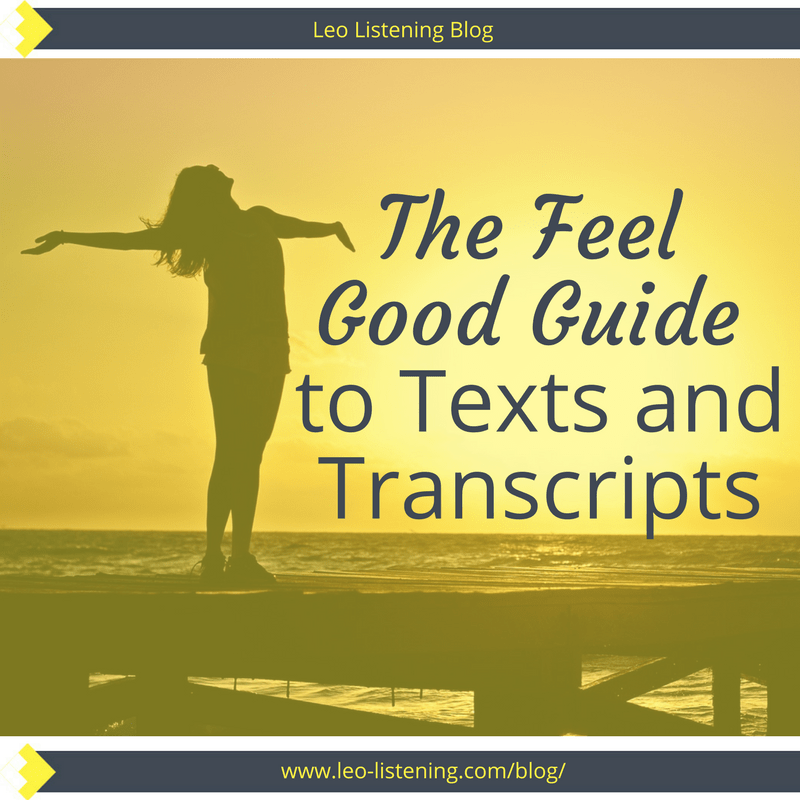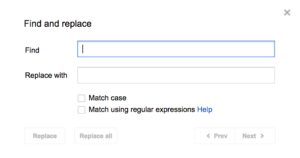The Feel Good Guide to Texts and Transcripts

Listen to this article as a blogcast or continue scrolling to read it.
Do you remember those times at school where you were allowed to listen to a recording in English and read along with the transcript at the same time?
If you answered no, then I’m not surprised.
I don’t remember doing that when I was learning French at school. The goal of listening back then was to sit their terrified hoping to catch a few words and answer the multiple choice questions.
That’s because nobody taught us how to listen.
- We didn’t learn the pronunciation rules that would have helped us not only sound better, but also hear better.
- We didn’t learn strategies for dealing with fast, spoken French. Well, apart from learning to say “Pouvez-vous répéter s’il vous plaît ?”
- We didn’t learn any techniques for improving our listening apart from:
– listen a lot or
– answer these comprehension questions.
The unspoken rule was that having a transcript is bad. It’s cheating. You should just listen and deal with it. If you listen with a text, then you’ll never improve your listening skills. And besides you can just guess from context if you don’t understand. And it’s okay to not catch every word.
But what good is just listening when
- You don’t know how the language sounds, how words join together or how sounds disappear.
- You don’t have effective strategies for your listening
- You’re relying on multiple choice or true or false questions to tell you if you’re any good. But the reality is you can guess the answers to these questions. And even if you do get the answer right, you don’t know why you’re right.
- You need to do more than just guess from context. What if you guess wrong? You could misinterpret an entire conversation. You could misunderstand important instructions from a boss or colleague. You could miss your train or your flight because you misheard the announcement (they just mentioned our flight number – but are they telling us it’s delayed or cancelled? It makes a big difference).
- What good is it to not worry about every word? The words that are hard to catch in English are precisely the words that ARE important!
Take the difference between affirmative and negative sentences for instance:
You should come and
You shouldn’t come
The first one could be a friendly invitation to a party or some other event. The second is a warning telling you not to attend. Pretty different meanings right?
The problem in English is that we squeeze all these little grammatical words into the same space. That’s why 2 similar sentences take the same amount of time to say. All those poor little grammatical words get squashed right down to the point where they’re very difficult to catch.
And if you don’t catch them, then you’re going to have communication problems. Even though, 9 times out of 10 you know these words perfectly well. Because you know the grammar of the language and you read often enough.
This is why you get stuck in these all too familiar situations. Can you identify with them?
- Reading subtitles for years and never getting the feeling that you’re improving. Or worse regressing because you’re just reading words you know but still can’t recognise in speech.
- Avoiding situations where you have to talk to groups of native speakers for fear of not understanding. Even when you can express yourself perfectly well. And people even compliment you on your English.
I’m proud to be a “broken record” on these issues because I’m so passionate about them.
I don’t want past assumptions like “transcripts are bad for your listening” to stop you from making progress.
You want to improve. You know what you’re doing at the moment isn’t working. You’re open to trying new ideas, even if you’re not confident with technology. And I’m so glad you’re here because I want to help you with exactly that.
I want to show you there’s nothing wrong or dangerous about using a transcript. If you have a text, you can do tons of cool stuff to enhance your listening.
Let’s take this blogcast episode for instance. Thanks to the text, you can create a fabulous Do It Yourself (DIY) listening activity that’ll help you better understand spoken English by training your ears to catch all those annoying grammatical words.
Are you ready to create a listening activity that’ll open your ears to how English really sounds?
Here’s what you can do with today’s blog post and blogcast.
1.Copy and paste the blog post into a word processing document. I live and breathe Google Docs, but this would also work in Microsoft Word, or Pages if you’re on a Mac.
- Do a find and replace search. What’s that you ask? If you’re on a PC press ctrl + F together. If you’re on a mac like me press command + F.
A little dialogue box will pop up. It should look at bit like this.
![]()
3.Click on the 3 little dots on the right. Another box will pop up that should look at bit like this.

- We’re going to remove some of the words you find hard to catch from the document.
You probably have a hard time with prepositions (to, for, from, of etc), articles (a, an, the) or auxiliary verbs (is, has, have, will, can etc).
In the ‘find’ box, type a word you find hard to catch. In the ‘replace with’ box, press the spacebar a couple of times.
Then click replace all.

- When you come back to your document, you’ll discover that all the ‘tos’ (or whichever word you chose) have been replaced by gaps. Well done, you’ve just created your own gap fill exercise.
Now, I know what you’re thinking. It’s a bit too easy if you know that every gap represents the word ‘to’.
Choose a few features you find difficult and gap them out. You just need to go back a couple of times and repeat the steps with another grammatical word. I recommend a conjunction like ‘and’ or a pronoun like ‘he’ but you can choose whichever words cause you the most problems.
What’s interesting though is that even with just the word ‘to’ gapped out, you can listen back and try to notice which ‘tos’ are easier to catch. Even a simple, tiny word like this can be pronounced by the same person in a multitude of different ways.
- Some ‘tos’ will be closer to the dictionary or careful pronunciation with the full /uː/ sound.
- Most will contain a relaxed schwa sound.
- Others will just be a /t/ sound with no vowel.
- In other cases, the following word or even the previous word will affect the way ‘to’ sounds.
- If the next sound is a vowel, you might notice a linking /w/ or /j/ sound.
The important thing to remember is that all these little words are on a continuum from most careful to most reduced.
As a native speaker, I’m skilled in taking the hardest to catch weak form that barely resembles anything and transforming it back into /tuː/. It’s easy for me because I’ve been practising since before I was born. Listening is the first language skill you develop. And you start doing so when you’re in your mother’s womb.
All the latest listening research suggests that you as a learner need to do these types of ear training exercise.
I know, I know it’s not as much fun as just sticking on a few podcasts while you’re cleaning the house or taking a walk.
But, like anything in life, if you treat it like a game, if you track and measure your progress, you can make it fun and effective.
What else can a transcript or text do for my listening?
- Transcripts build your confidence. Listening to a foreign language is a scary business. Words disappear faster than you can catch and understand them. If you’re in conversation with someone, you can’t go back. And you’ll know from experience that it gets awkward when you constantly ask people to repeat. Not that it’s much fun either to smile and nod and pretend you understand!
- When you’re starting out you can read along with the podcast or whatever you’re listening to and build your confidence by recognising how words you already know sound.
- You can then listen back to the podcast or recording without the transcript, feeling a little more confident.
- Once you’re feeling braver, you can listen first, then go back and listen with the transcript. After you can listen for a third time without the transcript and notice how much more you understand thanks to the transcript.
- To get in some serious ear training, you can do a dictation exercise. The transcript then gives you the answer and the insight as to why you didn’t understand.
Give yourself permission to feel good about transcripts
- Transcripts don’t have to hinder your listening: they can enhance it if you use them the right way
- Using a transcript is not cheating. In fact, it’s a proven way to scaffold your listening. What I mean by that is, it gives you the confidence to build on your skills. You can transition, just as you can from subtitles, from:
- reading and listening together
- To listening, then reading and checking
- To listening without a text. Or only using the text to do dictations with really tricky sections.
- As you’ve seen in this blog post and the others I’ve been writing over the last few weeks about blogcasting and podcast transcripts, having a text means you can create your own listening tasks. No more boring comprehension questions that don’t improve your understanding anyway!
Your next steps
If you’ve enjoyed this post, then you’ll also enjoy my blog post or my video on using the interactive transcripts on YouTube.
Blog post title image available at: https://pixabay.com/en/woman-girl-freedom-happy-sun-591576/